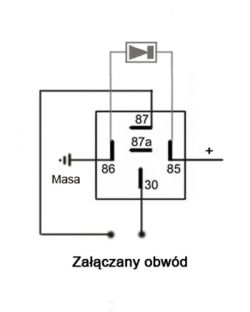_jta_ wrote: The diode is connected in parallel to the relay coil so that breaking the connection does not generate high voltages on the coil. This is especially important if the coil is controlled by a transistor - it can burn out if there is no diode. But also when controlling the button without the diode, the button contacts burn out faster.
Hello, taking the opportunity that such a topic was created, I will ask, that is, in any case, regardless of how we use such a relay, whether it's to start some additional halogens, or to cut off the pump, starter or ignition, or everything at once on several relays, then on each relay, such a diode is indicated on the power supply (I understand that rectifying or indifferent) connected with the cathode always to plus, and the anode to minus (as in the picture?) And it will not do any harm, on the contrary, it will be beneficial for the relay?

By the way, I will ask again, it is indifferent whether we give + 85 or 86 to the coil?






